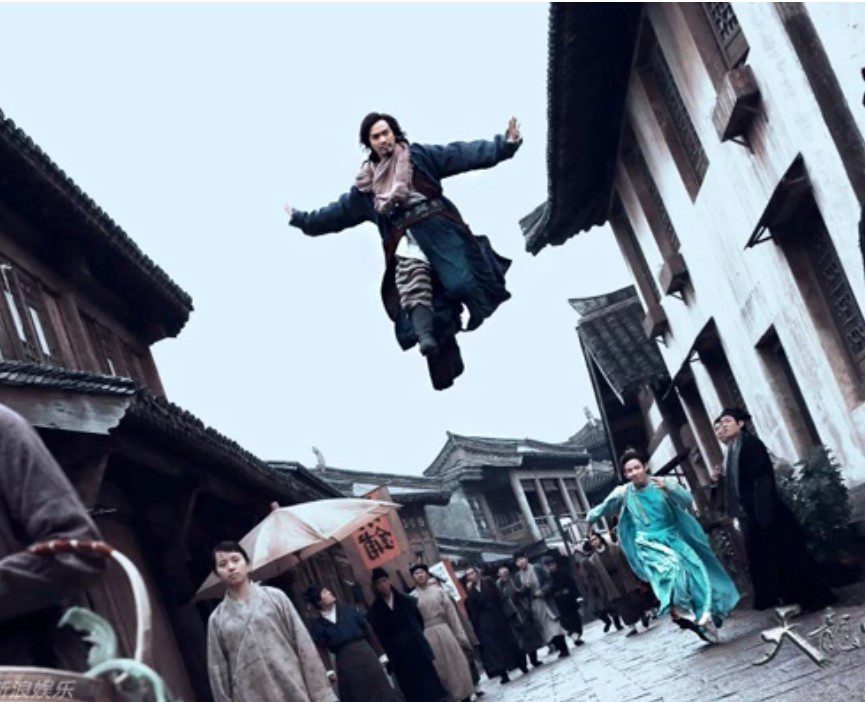Although time has passed, the legacy of the author Kim Dung remains eternal in the hearts of fans through his works, which have become legendary in the genre of martial arts novels.
His invaluable literary legacy includes 15 outstanding martial arts novels. Many of his works are not only known for their captivating stories but have also been adapted into films multiple times.
The distinctive feature of Kim Dung’s novels is not only the intriguing plots or the beloved characters but also the profound martial arts philosophies embedded within. Many fans note that every aspect of martial arts in Kim Dung’s stories reflects a strong essence and its own unique philosophy.

When referring to martial arts, one must mention “The Dark Shadow of the Heavenly Sword” created by Duong Qua. This martial art style was developed from the essence of martial arts, elevating one’s strength to its peak and is considered one of the top martial arts in ‘Heavenly Sword and Dragon Slaying Saber’. Regarding the techniques, the ‘Cô Cá»u Kiếm’ of Lệnh Hồ Xung is legendary, and this martial art, created by ‘Cô Cá»u Bái’, is capable of offering a unique application of martial arts on a higher level, being one of the foremost techniques in Kim Dung’s works.
As for agility techniques, ‘Cá»u DÆ°Æ¡ng Thần Công’ is recognized as the foundation, this is the only martial art that combines Buddhist martial arts into the works of Kim Dung. Ultimately, lightness skills, Kim Dung has depicted many types of lightness skills, such as the ‘Thượng thiên thế’ of Quách TÄ©nh, and the ‘Thê vân tung’ of TrÆ°Æ¡ng Tam Phong, all of which are lightness skills that dominate martial arts.
However, among many unique techniques, this lightness skill does not equate to a single technique of Äao Äà n Dá»±, which is notably the ‘Lãng ba vi bá»™’. The ‘Lãng ba vi bá»™’ in ‘Heavenly Sword and Dragon Slaying Saber’ is considered by many to be the ultimate divine skill, helping to evade all attacks and increase internal strength.
The unique value of lightness skills
Firstly, according to Kim Dung’s perspective, ‘Lãng ba vi bá»™’ can evade most martial arts attacks successfully. This technique is arranged according to the positions of 64 squares in the ‘Dịch Kinh’, while traditional martial arts in China do not fall outside the scope of this book. Therefore, after learning ‘Lãng ba vi bá»™’, no martial arts can be used effectively. Äao Äà n Dá»± often experienced great difficulties because of this reason.
Notably, despite knowing ‘Lãng ba vi bá»™’ but still not understanding how to use martial arts effectively, Äao Äà n Dá»± still achieved results and was favored by Nam Hải Ngá»c Thần, a character in the Third Volume of the ‘Äại Ãc Nhân’ series, and became the antagonist’s assistant.

In a moment of danger, when Äao Äà n Dá»± was in VÆ°Æ¡ng Ngữ Yên’s territory to escape from the pursuit of the Tây Hạ army, he had to confront Má»™ Dung Phục – a top martial artist from Giang Nam. Although Má»™ Dung Phục was indeed a high-ranking martial artist compared to Äao Äà n Dá»±, the unique ability of ‘Lãng ba vi bá»™’ helped Äao Äà n Dá»± to evade Má»™ Dung Phục’s attacks. Ultimately, Má»™ Dung Phục had to use a powerful move, risking his life to defeat VÆ°Æ¡ng Ngữ Yên in order to eliminate Äao Äà n Dá»±’s escape route.
Secondly, ‘Lãng ba vi bá»™’ can enhance internal strength. The book states that after practicing a complete set of ‘Lãng ba vi bá»™’, internal strength will increase, and with long-term practice, one can reach the top level in martial arts. These two characteristics are why ‘Lãng ba vi bá»™’ is regarded as the ultimate divine skill in the eyes of many martial arts enthusiasts.
Is the martial art technique rated too highly?
However, according to Sohu news, when analyzing the content of the story, this martial art technique may have been rated too highly and essentially serves as a specific application of martial arts.
This is evident through two distinct points.
Firstly, it is true that ‘Lãng ba vi bá»™’ can evade a significant portion of attacks in martial arts, but it cannot evade the ‘Giáng Long Tháºp Bát Chưởng’, ‘Nháºt DÆ°Æ¡ng Chỉ’, and ‘Lục Mạch Thần Kiếm’ which are also martial arts techniques of Thiếu Lâm. Because the Tiêu Dao sect does not gather the ultimate martial arts essence.
Furthermore, ‘Lãng ba vi bá»™’ was created based on the squares in ‘Dịch Kinh’, while martial arts from the Buddhist sect do not originate from ‘Dịch Kinh’. This indicates that when faced with other martial arts techniques, ‘Lãng ba vi bá»™’ can become ineffective. This also explains why Lý Thu Thủy did not use ‘Lãng ba vi bá»™’ when confronting Thiên SÆ¡n Äá»™ng because the martial arts of Thiên SÆ¡n Äá»™ng Lão are indeed the ultimate in martial arts.

Secondly, the movement speed of ‘Lãng ba vi bá»™’ is not as quick. The author has defined it as a slow-moving technique compared to Kiá»u Phong and Äao Äà n Dá»±. Kiá»u Phong has acknowledged that “in a brief confrontation, if Äao Äà n Dá»± does not use any techniques, then it is not difficult; but if he uses a few techniques, then the effectiveness of the approach will be significantly reduced.”
However, in reality, Äao Äà n Dá»± has much higher internal strength than Kiá»u Phong, making it certain that he will not lose. Yet, if facing a person with high internal strength like TrÆ°Æ¡ng Vô Kỵ, it is uncertain whether he can win. Additionally, while using ‘Lãng ba vi bá»™’, Äao Äà n Dá»± cannot surpass Kiá»u Phong in a brief confrontation, highlighting that this unique technique does not move as quickly as previously thought.
Summary

















